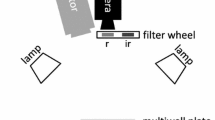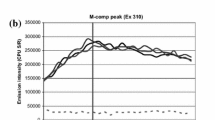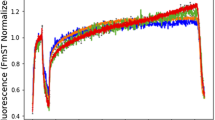Abstract
Pulse modulated fluorescence has increasingly been used as an ecological tool to examine changes in the vertical distribution of microphytobenthic cells within the upper layers of estuarine sediments (most often using the minimum fluorescence yield Fo) as well as to indicate the health of the community (using the maximum PS II quantum efficiency Fv/Fm). However, the practicalities of in situ measurements, often dictates that short dark adaptation periods must be used (∼15 min). The use of far-red light as an alternative to dark adaptation was investigated in natural migratory microphytobenthic biofilms and artificial non-migratory biofilms. Prolonged periods of darkness (∼24 h) were not adequate to achieve ‘true’ measurements of Fo and Fv/Fm, which require complete oxidation of QA and full reversal of non-photochemical quenching (NPQ). In some instances, stable values were only achieved using far-red light. Prolonged exposure to dark/far-red light led to a downwards migration of cells in natural assemblages, as seen by a reduction in both Fo and the maximum fluorescence yield (Fm). In non-migratory biofilms, Fm increased in the dark and far-red treatments, indicating a reversal of NPQ, whereas Fo decreased in far-red light but increased in the dark. It is suggested that far-red light and darkness differentially affected the balance between NPQ reversal and QA oxidation that lead to the measured Fo yield. The use of far-red light as an alternative to dark adaptation is discussed and the implications of short (e.g., 15 min) dark adaptation times used in situ are discussed with reference to the vertical migration of cells within sediment biofilms.
Similar content being viewed by others
References
Admiraal W (1984) The ecology of estuarine sediment inhabiting diatoms. Prog Phycol Res 3: 269
Barranguet C and Kromkamp J (2000) Estimating primary production rates from photosynthetic electron transport in estuarine microphytobenthos. Marine Ecol Progr Series 204: 39–52
Barranguet C, Kromkamp J and Peene J (1998) Factors controlling primary production and photosynthetic characteristics of intertidal microphytobenthos. Marine Ecol Progr Series 173: 117–126
Bennoun P (2002) The present model for chlororespiration. Photosynth Res 73: 273–277
Chamberlin WS, Booth CR, Kiefer DA, Morrow JH and Murphy RC (1990) Evidence for a simple relationship between natural fluorescence, photosynthesis and chlorophyll in the sea. Deep Sea Res 37: 951–973
Consalvey M (2002) The structure and function of microphytobenthic biofilms. PhD thesis, St. Andrews University, St. Andrews, UK (268)
Daborn GR, Amos CL, Brylinsky M and Christian H (1993) An ecological cascade effect: migratory birds affect stability of intertidal sediments. Limnol Oceanogr 38: 225–231
Dade WB, Davis JD, Nichols PD, Nowell ARM, Thistle D, Trexler MB and White DC (1990) Effects of bacterial exoplymer adhesion on the entrainment of sand. Geomicrobiol J 8: 1–16
Decho AW and Lopez GR (1993) Exopolymer microenvironments of microbial flora — multiple and interactive effects on trophic relationships. Limnol Oceanogr 38: 1633–1645
Dodds WK (1992) A modified fiber-optic light microprobe to measure spherically integrated photosynthetic photon flux density: characterisation of periphyton photosynthesis-irradiance patters. Limnol Oceanogr 37: 871–878
Eaton JW and Moss B (1966) The estimation of numbers and pigment content in epipelic algal populations. Limnol Oceanogr 11: 584–595
Edgar LA (1983) Mucilage secretions of moving diatoms. Protoplasma 118: 44–48
Edgar LA and Pickett-Heaps JD (1984) Diatom locomotion. In: Vol. 3. Round FE and Chapman DJ (eds) Progress in Phycological Research, Biopress, Bristol, UK
Genty B, Briantais J-M and Baker NR (1989) The relationship between the quantum yield of photosynthetic electron transport and quenching of cholorophyll fluorescence. Biochem Biophys Acta 990: 87–92
Guillard RRL and Ryther JH (1962) Studies of marine planktonic diatoms. I. Cyclotella nana Hustedt, and Detonula confervacea (Cleve) Gran. Can J Marine Biol 27: 191–196
Happey-Wood CM and Jones P (1988) Rhythms of vertical migration and motility in intertidal benthic diatoms with particular reference to Pleurosigma angulatum. Diatom Res 3: 83–93
Hartig P, Wolfstein K, Lippemeier S and Colijn F (1998) Photosynthetic activity of natural microphytobenthos populations measured by fluorescence (PAM) and 14C-tracer methods: a comparison. Marine Ecol Progr Series 166: 53–62
Hay SI, Maitland TC and Paterson DM (1993) The speed of diatom migration through natural and artificial substrata. Diatom Res 8: 371–384
Honeywill C (2001) In situ analysis of the biomass and distribution of micropytobenthos. PhD thesis, St. Andrews University, St. Andrews, UK (156)
Honeywill C, Paterson DM and Hagerthey SE (2002) Instant determination of microphytobenthic biomass using pulse modulated minimum fluorescence. Eur J Phycol 37: 485-492
Horton P, Ruban AV and Walters RG (1996) Regulation of light harvesting in green plants. Ann Rev Plant Physiol Plant Mol Biol 47: 655–684
Janssen M, Hust M, Rhiel E and Krumbein WR (1992) Vertical migration behaviour of diatom assemblages of Waddem Sea sediments (Dangast, Germany): a study using cryo-scanning electron microscopy. Int Microbiol 2: 103–111
Jørgensen BB and Des Marais DJ (1986) A simple fiber-optic microprobe for high resolution light measurements: application in marine sediment. Limnol Oceanogr 31: 1376–1383
Jørgensen BB and Des Marais DJD (1988) Optical properties of benthic photosynthetic communities: fiber-optic studies of cynaobacterial mats. Limnol Oceanogr 33: 99–113
Kiefer DA, Chamberlin WS and Booth CR (1989) Natural fluorescence of chlorophyll a: relationship to photosynthesis and chlorophyll concentration in the western South Pacific. Limnol Oceanogr 34: 868–881
Kromkamp J, Barranguet C and Peene J (1998) Determination of microphytobenthos PS II quantum efficiency and photosynthetic activity by means of variable chlorophyll fluorescence. Marine Ecol Progr Series 162: 45–55
Kuhl M and Jørgensen BB (1992) Spectral light measurements in microbenthic phototrophic communities with a fiber-optic microprobe coupled to a sensitive diode array detector. Limnol Oceanogr 37: 1813–1823
Lassen C, Ploug H and Jørgensen BB (1992a) A fibre-optic scalar irradiance microsensor: application for spectral light measurements in sediments. FEMS Microbiol Ecol 86: 247–254
Lassen C, Ploug H and Jørgensen BB (1992b) Microalgal photosynthesis and spectral scalar irradiance in coastal marine sediments of Limfjorden, Denmark. Limnol Oceanogr 37: 760–772
Lawson T, Oxborough K, Morison JIL and Baker NR (2002) Responses of photosynthetic electron transport in stomatal guard cells and mesophyll cells in intact leaves to light, CO2 and humidity. Plant Physiol 128: 52–62
Lorenzen CJ (1966) A method for the continuous measurement of in vivo chlorophyll concentration. Deep Sea Res 13: 233–227
MacIntyre HL, Geider RJ and Miller DC (1996) Microphytobenthos: the ecological role of the "secret garden' of unvegetated, shallow water marine habitats I. Distribution, abundance and primary production. Estuaries 19: 186–201
Mouget J-L and Tremblin G (2002) Suitability of the Fluorescence Monitoring System (FMS, Hansatech) for measurement of photosynthetic characteristics in algae. Aquatic Bot 1597: 1–13
Olaizola M and Yamamoto HY (1994) Short term response of the diadinoxanthin cycle and fluorescence yield to high irradiance in Chaetoceros muelleri (Bacillariophyceae). J Phycol 30: 606–612
Palmer JD and Round FE (1965) Persistent, vertical-migration rhythms in benthic microflora. I. The effect of light and temperature on the rhythmic behaviour of Euglena obtusa. J Marine Biol Assoc UK 45: 567–582
Paterson DM (1995) Biogenic structure of early sediment fabric vizualised by low temperature scanning electron microscopy. J Geol Soc 152: 131–141
Paterson DM, Crawford RM and Little C (1986) The structure of benthic diatom assemblages: a preliminary account of the use and evaluation of low-temperature scanning electron microscopy. J Exp Marine Biol Ecol 96: 279–289
Paterson DM, Wiltshire KH, Miles A, Blackburn J, Davidson I, Yates MG, McGrorty S and Eastwood JA (1998) Microbiological mediation of spectral reflectance from intertidal cohesive sediments. Limnol Oceanogr 43: 1207–1221
Perkins RG, Underwood GJC, Brotas V, Snow GC, Jesus B and Ribeiro L (2001) Response of microphytobenthos to light: primary production and carbohydrate allocation over an emersion period. Marine Ecol Progr Series 223: 101–112
Perkins RG, Oxborough K, Hanlon ARM, Underwood GJC and Baker NR (2002) Can chlorophyll fluorescence be used to estimate the rate of photosynthetic electron transport within microphytobenthic biofilms? Marine Ecol Progr Series 228: 47–56
Pinckney J, Piceno Y and Lovell CR (1994) Short term changes in the vertical distribution of benthic microalgal biomass in intertidal muddy sediments. Diatom Res 9: 143–153
Ploug HLC and Jørgensen BB (1993) Action spectra of microalgal photosynthesis and depth distribution of spectral scalar irradiance in a coastal marine sediment of Limfjorden, Denmark. FEMS Microbiol Ecol 12: 69–78
Round FE and Palmer JD (1966) Persistent, vertical-migration rhythms in benthic microflora. J Marine Biol Assoc UK 46: 191–214
Serôdio J, Marques da Silva J and Catarino F (1997) Nondestructive tracing of migratory rhythms of intertidal benthic microalgae using in vivo chlorophyll a fluorescence. J Phycol 33: 542–553
Serôdio J, Marques da Silva J and Catarino F (2001) Use of in vivo chlorophyll a fluorescence to quantify short term variations in the productive biomass of intertidal microphytobenthos. Marine Ecol Progr Series 218: 45–61
Smith DJ and Underwood GJ (1998) Exopolymer production by intertidal epipelic diatoms. Limnol Oceanogr 43: 1578–1591
Taylor IS and Paterson DM (1998) Microspatial variation in carbohydrate concentrations with depth in the upper millimetres of intertidal cohesive sediments. Estuaries Coastal Shelf Sci 46: 359–370
Underwood GJC (1994) Seasonal and spatial variation in epipelic diatom assemblages in the Severn estuary. Diatom Res 9: 451–472
Underwood GJC and Kromkamp J (1999) Primary production by phytoplankton and microphytobenthos in estuaries. In: Nedwell DB and Raffaelli DG (eds) Advances in Ecological Research Estuaries, Vol. 29, pp 93–153. Academic Press, London
Underwood GJC and Paterson DM (1993) Recovery of intertidal benthic diatoms after biocide treatment and associated sediment dynamics. J Marine Biol Assoc UK 73: 25–45
Underwood GJC, Paterson DM and Parkes RJ (1995) The measurement of microbial carbohydrate exopolymers from intertidal sediments. Limnol Oceanogr 40: 1243–1253
Wiltshire KH, Blackburn J and Paterson DM (1997) The Cryolander: a new method for fine scale in situ sampling of intertidal surface sediments. J Sediment Res 67: 977–981
Yentsch CS and Menzel DM (1963) A method for the determination of phytoplankton, chlorophyll and phaeophytin by fluorescence. Deep Sea Res 10: 221–231
Author information
Authors and Affiliations
Rights and permissions
About this article
Cite this article
Consalvey, M., Jesus, B., Perkins, R. et al. Monitoring Migration and Measuring Biomass in Benthic Biofilms: The Effects of Dark/far-red Adaptation and Vertical Migration on Fluorescence Measurements. Photosynthesis Research 81, 91–101 (2004). https://doi.org/10.1023/B:PRES.0000028397.86495.b5
Issue Date:
DOI: https://doi.org/10.1023/B:PRES.0000028397.86495.b5




